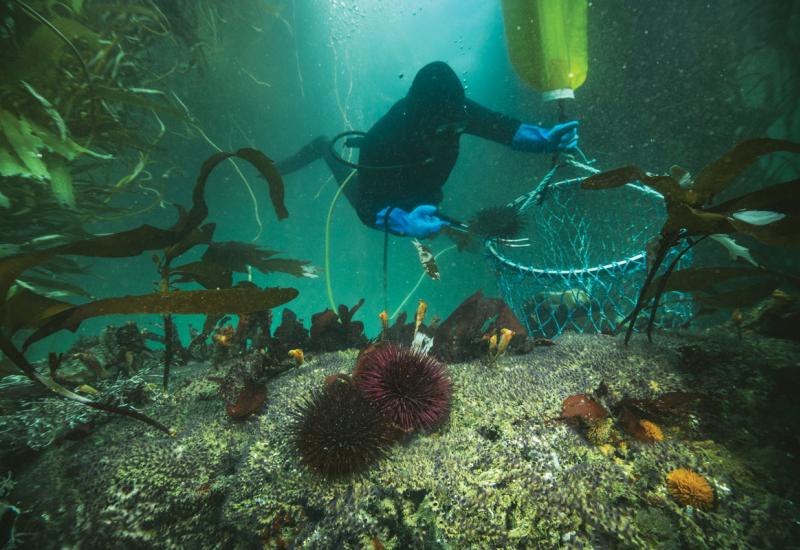Expert Alex Mustard Shares His Secrets on How to Photograph Dolphins in the Wild

Alex MustardGEAR Nikon D5 with 13mm fisheye lens
SETTINGS f/13; 1/250; ISO 500
Seeing dolphins from the boat or underwater is the highlight of any ocean day. Encounters can be tough to photograph because they are unpredictable and highly variable, but few subjects will be so warmly appreciated by your friends.
Often the only warning you’ll get from dolphins is their squeaking calls. If you are lucky, they will suddenly burst into view, and then just as quickly vanish.
If you’re more fortunate, you might be able to snorkel with friendly dolphins for an extended encounter—as long as you can keep up! Or you might be the luckiest of all and have curious dolphins come and check you out. I’ll cover techniques for all three types of encounters below.
The unpredictable fly-past is the most common dolphin encounter and most unpredictable to photograph. If the dolphins don’t come close, turn off your strobes and shoot them in available light, perhaps as a silhouette if they go overhead. Modern cameras and processing will produce surprisingly pleasing color shots, or if they stay too distant, you can convert the images to striking black-and-white.
One option I often gamble on is to swim to the reef, find a nice subject and hope that the dolphins might provide the perfect background. The advantage is that the dolphins don’t need to come too close, but it requires a slice of luck that they appear in roughly the right place.
Related Reading: The Six Best Destinations for Underwater Photography
Snorkeling with dolphins is how most encounters happen. My advice is to leave your strobes behind, grab a snorkel and go. Dither, and they’ll be gone! You never know if you will get a good encounter, but if you don’t try, you definitely have no chance. Dolphins are not the ocean’s most colorful critters, so flash adds very little to pictures, but the main reason to leave them behind is that strobes and arms attached to your camera slow you down. Being maneuverable in the water gets you into the best positions and makes you more interesting to the dolphins.
Shutter speed is the most important setting for dolphins. If your shutter speed is too slow and you don’t use flash, the dolphins will blur. Auto exposure does work well, with about -0.7 to -1 stop exposure compensation to keep the water a rich blue. I suggest either using shutter priority auto exposure (Tv or S) so you can set a fast shutter speed and the camera will vary the aperture to give the correct exposure, or using auto ISO. This allows you to choose the shutter speed and aperture while the camera adjusts the ISO to create the correct exposure.
I also engage continuous shooting so that I can get multiple frames of the best pass. Three to five frames per second is ideal. Autofocus is very reliable with dolphins, so I just use my standard wideangle settings with back-button focus.
On very lucky days, you can meet friendly dolphins on dives. In many ways, these encounters are the easiest to shoot. The main challenge is getting enough light on them, because although they will feel close, they will actually be far away in underwater photography terms. Your strobes need to be out wide, on higher power, and you should bump the ISO up and open the aperture a bit to help the strobe reach while increasing the shutter speed to maintain the exposure of the blue.

Alex MustardGEAR Nikon D700 with 16mm fisheye lens
SETTINGS f/10; 1/500; ISO 400
BEHIND THE SHOT
1 It’s rare to have the chance to photograph dolphins with flash. But you can when curious individuals come close. The bottlenose dolphins of Egypt (pictured here) and Socorro are classic examples. Since most dolphin shots are taken near the surface, in open water and without flash, diving encounters give us the chance for something different. In Socorro, I like to try and work a sunburst and the distance surface into the shot, while in the Red Sea, I look to work the reef or wreck into the background picture.
2 All dolphin photos look good on the back of the camera, but time and again, I see photographers disappointed when they download because the details are not sharp. Dolphins move fast across the frame, especially when they come close, and if you spend a day snorkeling and shooting without flash, it is easy to slightly blur all your shots. The Bahamas, where these Atlantic spotted dolphins live, is a famous spot for encounters, and I have seen people shoot an entire encounter using the wrong settings. If you take nothing else from this article, remember that dolphins need shutter speed. Push the ISO and open the aperture if needed, but use a shutter speed of 1/500 and you will get details sharp.
Related Reading: Find the Best Places to Swim with Whales
WHERE TO SEE THEM
Dolphins can be found throughout the ocean. I’ve seen the largest dolphin species, the orca, in polar waters and on the equator. The popular diving destination of the Red Sea is one of my favorite places for dolphin encounters because they often happen naturally as part of a normal liveaboard diving trip.
On one trip in 2021, we dived three different wrecks in one day, and each time were accompanied by dolphins. The dolphins here typically have home reefs known as dolphin houses, such as Sha’ab El Urg near Hurghada and Sataya Reef near Berenice, which offer good chances of meeting bottlenose and spinner dolphins, respectively.










